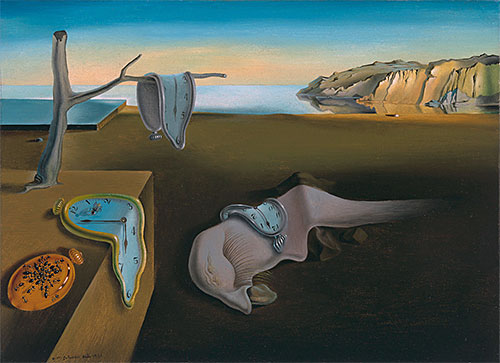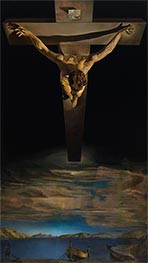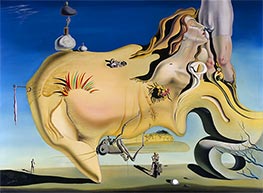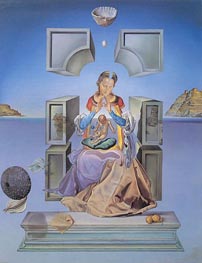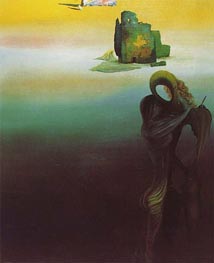The Persistence of Memory, 1931 by Salvador Dali
Canvas Print - 3408-DAS
Location: Museum of Modern Art, New York, USAOriginal Size: 24 x 33 cm
Giclée Canvas Print | $53.94 USD
Your Selection
Customize Your Print
By using the red up or down arrows, you have the option to proportionally increase or decrease the printed area in inches as per your preference.
*Max printing size: 25.8 x 35.4 in
*Max framing size: Long side up to 28"
"The Persistence of Memory" will be custom-printed for your order using the latest giclée printing technology. This technique ensures that the Canvas Print captures an exceptional level of detail, showcasing vibrant and vivid colors with remarkable clarity.
Our use of the finest quality, fine-textured canvas lends art reproductions a painting-like appearance. Combined with a satin-gloss coating, it delivers exceptional print outcomes, showcasing vivid colors, intricate details, deep blacks, and impeccable contrasts. The canvas structure is also highly compatible with canvas stretching frames, further enhancing its versatility.
To ensure proper stretching of the artwork on the stretcher-bar, we add additional blank borders around the printed area on all sides.
Our printing process utilizes cutting-edge technology and employs the Giclée printmaking method, ensuring exceptional quality. The colors undergo independent verification, guaranteeing a lifespan of over 100 years.
Please note that there are postal restrictions limiting the size of framed prints to a maximum of 28 inches along the longest side of the painting. If you desire a larger art print, we recommend utilizing the services of your local framing studio.
*It is important to mention that the framing option is unavailable for certain paintings, such as those with oval or round shapes.
If you select a frameless art print of "The Persistence of Memory" by Dali, it will be prepared for shipment within 48 hours. However, if you prefer a framed artwork, the printing and framing process will typically require approximately 7-8 days before it is ready to be shipped.
We provide complimentary delivery for up to two unframed (rolled-up) art prints in a single order. Our standard delivery is free and typically takes 10-14 working days to arrive.
For faster shipping, we also offer express DHL shipping, which usually takes 2-4 working days. The cost of express shipping is determined by the weight and volume of the shipment, as well as the delivery destination.
Once you have added the paintings to your shopping cart, you can use the "Shipping estimates" tool to obtain information about available transport services and their respective prices.
All unframed art prints are delivered rolled up in secure postal tubes, ensuring their protection during transportation. Framed art prints, on the other hand, are shipped in cardboard packaging with additional corner protectors for added safety.
Painting Information
In Salvador Dalí’s "The Persistence of Memory," we are confronted with a scene where reality unravels at the edges, where time itself appears to dissolve into the landscape. The surrealist dreamscape Dalí conjures feels unnervingly still, yet the objects within it - especially the melting clocks - suggest a world that is quietly slipping away from any sense of order or permanence. This is not merely a flight of fancy; it’s a profound commentary on the fragility of time, memory, and existence itself.
The clocks are the most striking feature. Their soft, almost liquid form is deeply unsettling. Objects that we rely on for structure and measurement - timepieces, rigid in their normal state - have here become pliable, useless. They drape across barren surfaces: one hangs limply over the edge of a ledge, another folds over the branch of a leafless tree, while a third clings to the distorted, almost fleshy figure that dominates the center of the composition. The way these clocks collapse challenges the idea of time as something steady and unyielding, instead rendering it fragile and strange, slipping through our fingers like something half-remembered.
Dalí's use of color is highly deliberate, with the barren brown and beige tones of the foreground contrasting sharply against the cool blues and pale oranges of the distant horizon. The sky is painted in gradients that suggest a calm dusk, adding an eerie tranquility to the composition. The cliffs in the distance, reminiscent of the rugged coastline of Dalí’s native Catalonia, provide a faint link to reality, but they feel remote, as if they belong to a different world entirely. It is this tension between the familiar and the surreal that gives the painting much of its unsettling power.
At the center of the composition lies one of Dalí’s signature strange forms: a limp, amorphous creature that is simultaneously alien and disturbingly human. This strange figure, which may be a distorted version of Dalí’s own profile, is draped across the ground in a state of disintegration. Its long, insect-like eyelashes and the soft, fleshy texture of its form add a grotesque organic quality to the scene, as if it is some surreal mutation that hovers between life and death. It embodies the surrealist obsession with the subconscious - a place where the familiar twists into the nightmarish, where identity and form are fluid.
Then, we find the ants - seemingly insignificant at first, but crucial to the painting’s thematic depth. Crawling over a gold pocket watch in the corner, the ants evoke decay and impermanence. They are Dalí’s recurring symbol for the rot beneath the surface, and here, they feast on the remnants of time itself. Even something as seemingly indestructible as a metal watch is reduced to something that can decay, eaten away by these tiny creatures. The ants introduce an organic decay that contrasts with the barren, inhuman landscape, reminding us of the inevitability of entropy.
The painting's overall composition is strikingly minimal yet deeply evocative. Dalí’s use of precise brushwork - every detail meticulously rendered - creates a sense of clarity and realism within a fundamentally surreal image. The clarity draws us in, but once we are inside this world, nothing feels solid or reliable. The delicate balance between reality and dream - the tangible and the irrational - makes this painting not just a surrealist fantasy, but a meditation on the fragility of time and the instability of existence.
In "The Persistence of Memory," Dalí presents us with a world where the laws of time and space are suspended. It is a world that feels both intimate and cosmic, where memory and reality blur, leaving us with the unsettling realization that nothing - not even time itself - is immune to decay. Dalí invites us to linger in this space, to ponder the fleeting nature of life and the strange fluidity of memory. What remains long after we have left the painting is that haunting sense of impermanence, as if everything solid has started to melt away.
